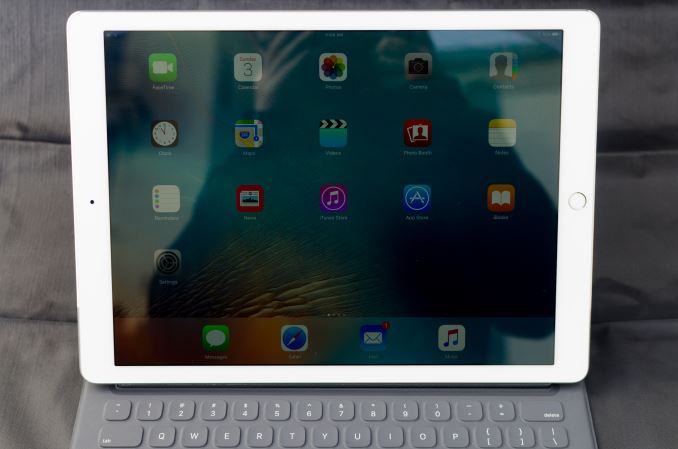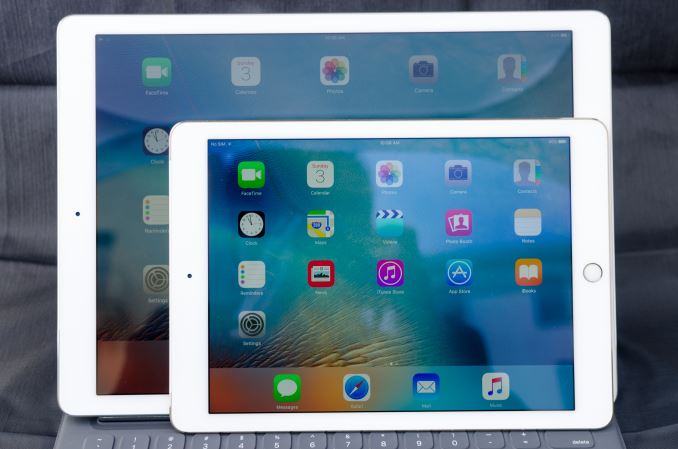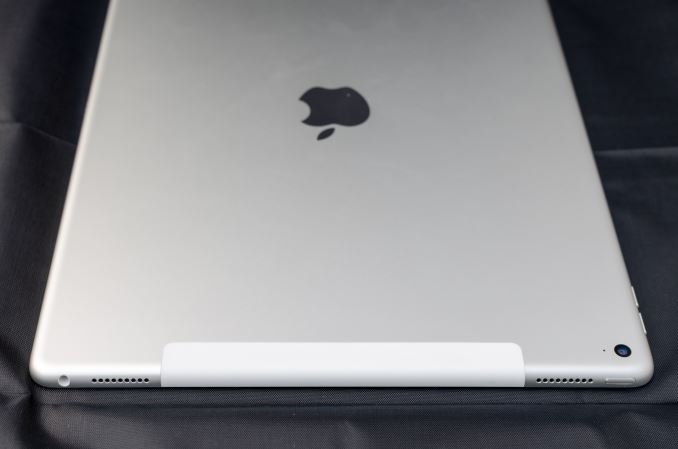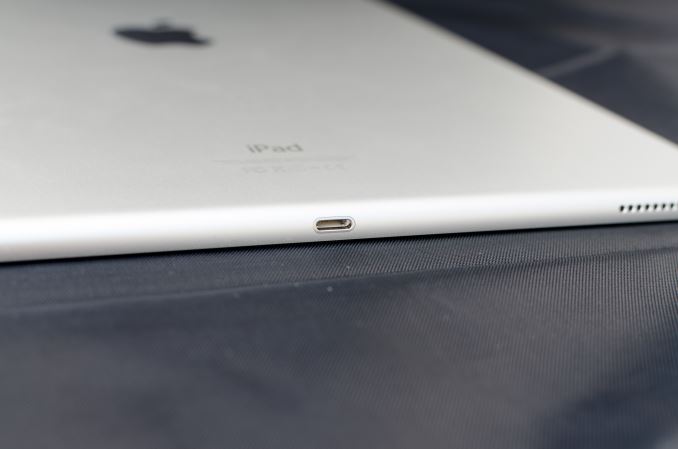The Apple iPad Pro Review
by Ryan Smith, Joshua Ho & Brandon Chester on January 22, 2016 8:10 AM EST
At this point it probably isn’t a secret that tablet sales have leveled off, and in some cases they have declined. Pretty much anywhere you care to look you’ll see evidence that the tablet market just isn’t as strong as it once was. It’s undeniable that touch-only tablets have utility, but it seems that the broader market has been rather lukewarm about tablets. I suspect at least part of the problem here is that the rise of the phablet has supplanted small tablets. Large tablets are nice to have, but almost feel like a luxury good when they’re about as portable as an ultrabook. While a compact laptop can’t easily be used while standing, or any number of other situations where a tablet is going to be better, a compact laptop can do pretty much anything a touch-only tablet can. A laptop is also going to be clearly superior for a significant number of cases, such as typing or precise pointing.
As a result, large touch-only tablets feel like they’ve been limited to home use as a computer away from the computer. Tablets are great when you’re on the couch or in bed, but once you get to this point there are some obvious questions as to whether it makes sense to drop $500+ USD on a tablet that seems to have relatively limited utility. The Surface lineup has been showing signs of growth, but in general the Surface is more of a mix between laptop and tablet rather than a tablet. I would argue that given the OS and overall design that the Surface and Surface Pro are really more laptop than tablet, even if at the hardware level the Surface Pro 4 and Surface 3 are basically tablets with kickstands and keyboard covers.
If you’re guessing that this means Apple has had some issues with growing sales of their iPad lineup, you’d be right. From my first experiences with the iPad 3, I was impressed with the improved user experience for things like web browsing and other smartphone tasks, but I never really felt like it made enough sense to get one for myself. The iPad Air 2 was once again impressive and I felt like I could recommend it to other people that wanted a tablet, but I personally struggled to come up with a reason why I would buy it.
This brings us to the iPad Pro. This is probably the first time Apple has seriously deviated from traditional iPad launches, putting together a tablet built for (limited) productivity and content creation rather than just simple content consumption, creating what's arguably the iPad answer to the Surface Pro. To accomplish this, Apple has increased the display size to something closer to that of a laptop, and we see the addition of a stylus and a keyboard cover for additional precision inputs. Of course, under the hood there have been a lot of changes as well, so the usual spec sheet can be found below to summarize those changes.
| Apple iPad Air 2 | Apple iPad Pro | |
| SoC | Apple A8X 3 x Apple Typhoon @ 1.5GHz |
Apple A9X 2 x Apple Twister @ 2.2GHz |
| GPU | PowerVR 8 Cluster Series6XT (Apple GXA6850) |
PowerVR 12 Cluster Series7XT |
| RAM | 2GB LPDDR3 | 4GB LPDDR4 |
| NAND | 16/64/128GB | 32/128GB |
| Display | 9.7" 2048x1536 IPS LCD | 12.9" 2732x2048 IPS LCD |
| Size and Mass | 240 x 169.5 x 6.1mm 437g WiFi, 444g LTE |
305.7 x 220.6 x 6.9 mm 713g WiFi, 723g LTE |
| Camera | 8MP Rear-Facing, f/2.4, 1.1 micron, 1.2MP Front-Facing, f/2.2 | |
| Battery | 27.3Wh | 38.5Wh |
| Launch OS | iOS 8 | iOS 9 |
| Cellular Connectivity | MDM9x25 Category 4 LTE + GPS/GNSS in Cellular SKU | |
| Other Connectivity | 2x2 802.11a/b/g/n/ac + BT 4.2, Apple Lightning | |
| SIM | Optional NanoSIM | |
| Price | $499/599/699 16/64/128GB | $799/949/1079 32/128GB/128GB LTE |
At a high level, the iPad Pro gains a larger display with a higher resolution, more memory, a new SoC, and a larger battery to compensate for the change in display size. In addition to these changes, the iPad Pro also brings noticeable changes to the speakers, with an increase to four speakers which allow the iPad Pro to compensate for device orientation when projecting stereo audio.
Design
The most immediate change that you can see in the iPad Pro is the sheer size. The 12.9” display of the iPad Pro basically makes it feel like you’re carrying a laptop around. I would argue that this doesn’t actually affect the portability of the iPad Pro, but this is mostly because the iPad Air 2 was something that I only carried in a backpack to begin with. People carrying their tablets in a small bag, purse, or even just in their hands will notice the difference, so the change in size might be more or less noticeable depending upon how you carry things around.
The increase in size does affect weight. After significant use, I honestly don’t think the mass is a significant issue. It does feel heavier than the iPad Air 2, but the mass distribution is such that there isn’t a ton of battery hanging out at the edges of the device where it’ll affect the moment of inertia. This does raise the question of whether Apple included enough battery for sufficient battery life, but that’s a question best left for the rest of the review.
In terms of design, the iPad Pro is rather unremarkable if you’ve ever seen an iPad Air before; it is for all intents and purposes a bigger iPad Air. On the front, the display dominates, with some bezels on the sides and top. The top has the front-facing camera, and the bottom has the home button with TouchID.
Looking at the sides of the tablet, the top edge has the power button and 3.5mm port, along with two of the four speakers. The right edge has the volume buttons, and the bottom edge has the Lightning port and the other two speakers. The left edge is mostly empty, but contains the Smart Connector for the Smart Keyboard and similar accessories.
The back of the tablet is mostly unremarkable as well. For the LTE model, an RF window is visible on the top of the device to allow LTE and other connectivity to function. For the WiFi variants, it looks like the bottom display bezel and the bottom two speakers are the RF windows, so there aren’t any visible areas that indicate where the WiFi antennas are.
Overall, the iPad Pro feels like an iPad, with nothing all that remarkable beyond its size which is carried well. I never really noticed the mass or size of the iPad Pro even if it is clearly larger and heavier than the iPad Air 2. I also didn’t notice any issues with the back cover flexing, but given enough pressure on the back cover pretty much any device this large will see some screen distortion or bending. The iPad Pro does technically regress in thickness compared to the iPad Air 2, but I never noticed the difference in practice, especially when the larger display is really what matters more.
















408 Comments
View All Comments
tim851 - Friday, January 22, 2016 - link
"Pro" is just a marketing moniker. There are smartphones that carry it.Apple wants iOS to succeed. People wonder if OSX will come to the iPad, I think Apple would rather consider bringing iOS to Macs. They are fanatical about simplicity and an iPad with iOS got that in spades.
And that's why they are taking the opposite approach of Microsoft.
Microsoft is trying to make their desktop OS touch-friendly enough. Apple is trying to make their touch OS productive enough.
Windows devs are by and large ignoring Metro, the tough UI, and just deploy desktop apps. Apple wants to force devs to find ways to bring professional grade software to iOS.
I'm quite happy that the two companies are exploring different avenues instead of racing into the same direction.
ddriver - Friday, January 22, 2016 - link
"I'm quite happy"People should really have higher standards of expectations, because otherwise, the industry will take its sweet time milking them and barely making any increments in the value and capabilities of their products. They won't make it better until people demand better, the industry is currently in a sweet spot where it gets to dictate demand, by lowering people's expectations to the point they don't know and can't even imagine any better than what the industry makes.
People should stop following the trends dictated by the industry, and really should look beyond that, which the industry is willing to do at this point, towards what is now possible to do and has been for a while really. Because otherwise, no matter how much technology progresses, this will not be reflected by the capabilities of people, if it is up to the industry, it will keep putting that into almost useless shiny toys rather than the productivity tools they could be.
exanimo - Monday, January 25, 2016 - link
ddriver, I want to start out by commending you on your writing and ideas. Top notch, really.I also really enjoy your idealist approach to saying that people should be dictating the industry, rather than vice versa (seriously). My only question is how can one do that as a consumer? Is seems to me that we have little or no choice but to follow trends because Google, Apple, and Microsoft are becoming too big to fail.
A perfect anecdote would be BlackBerry's OS10. They came late to the show (after they realized you can be too big to fail when you become stagnant) and released a technically superior mobile OS that had the consistency and reliability of iOS, with the control and versatility of Android. On top of that was the use of gestures and an amalgamated hub for messages. I wish I had a choice to use this operating system, but the writing on the wall says that it will collapse within the next 2 years. This is because they're still losing market shares and people are not supporting applications.
There is innovation, but it's stomped out by these huge companies and THE PEOPLE that dictate which OS to develop for.
The Hardcard - Friday, January 22, 2016 - link
What software do you use that came out in 1981 when the PC launched. Probably none. Virtually guaranteed none. It is surprising the lack of forward vision sometimes. In five years there will be plenty of professional software on iOS, to run on the significantly more powerful iPad Pro Whatever. The writing is on the wall.ddriver - Friday, January 22, 2016 - link
There were barely any software development tools back then, and barely any software developers for that matter. Today there is plenty of software development tools, and plenty of software developers, plus mobile devices have been around for a while. Yet none of those seems to produce any professional software, despite all the time and the fact the hardware is good enough. As I said earlier, this is entirely due to the philosophy, advocated for mobile devices - those should not be tools for consumers to use, but tools through which the consumers are being used. This market was inventing for milking people, not for making them more capable and productive.andrewaggb - Friday, January 22, 2016 - link
I think it really goes back to what a person needs to be productive. For some people that is just a web browser (eg chromebook). I have no doubt that the iPad pro may be productive for some people/uses and be everything they need in a computing device.In my case, as a windows/linux/web software developer I need a windows machine (or vm), with visual studio, sql server, eclipse, postgres, ms office, and various supporting apps. For me a chromebook or ipad is not a pro device or really even useful. I have various co-workers with SP3/4's + dock that drive dual screens and peripherals and get by ok. I like to run vm's and various other things that cause 16gb of ram to not be enough, so I'm stuck in desktop/premium laptop territory. I really don't mind that.
Personally - I barely use my ipad air and ended up installing crouton (ubuntu) on the chromebook. I'm sure other people are different.
Different devices for different kinds of professionals.
lilmoe - Friday, January 22, 2016 - link
Your point?$1000 laptops (even from Apple) are MUCH more powerful already, and they will get even more powerful. Same can be said about $1000 Windows 10 tablets. Technology will always progress, this isn't restricted to iPads.
Why is everyone trying to make iOS for professional productivity a thing? Why torture ourselves? Do you guys really believe it's only about computing power, which by the way isn't nearly close to being adequate? Good luck moving that 200GB RAW 4K video clip on that thing, let alone edit it. Good luck using it for 3D modelling and engineering. Good luck writing and compiling software...
As pointless as the new Macbook was, it sure as heck is a lot better than this thing for what it's advertised for...
This is an accessory, NOT a pro product. "The writing is on the wall"...................
ddriver - Friday, January 22, 2016 - link
"Why is everyone trying to make iOS for professional productivity a thing?"You ENTIRELY miss the point, which is "why is NOBODY doing it". It is a computer, REDUCED to an accessory, which COULD be THAT MUCH MORE USEFUL.
Actually, using OpenCL even mobile hardware can process high resolution video faster than a good video workstation was capable not 5 years ago. The hardware is perfectly capable of audio, video editing, 3d modelling, graphics, engineering, software development and whatnot. It is not as fast as the fastest desktop workstation, but it is fast enough to do the job, while still being very portable. All it lacks is the software to do it.
lilmoe - Friday, January 22, 2016 - link
Cool story, nice mood swings, you're amazing. lolBut still. Why torture yourself with iOS running on crippled "hardware", when there are devices that do iPad stuff better than iPads, run desktop class OSs and already have the software you need for the engineering and productivity stuff.
Because buying multiple devices to accomplish one task is a better thing to do?
ddriver - Friday, January 22, 2016 - link
What a touching attempt at condescending cynicism. Alas, as always you get things the wrongest way possible. Those capitalized words were not the product of mood, but motivated by your poor cognitive abilities, a last resort attempt at making the painfully obvious a tad more obvious, so that hopefully, you could finally get it. Unfortunately, you seem to be entirely hopeless."Because buying multiple devices to accomplish one task is a better thing to do?"
It is you who advocates such things. My point is exactly that - given the proper software, an ipad would be all that is needed, no need to buy an ipad AND a laptop to get your work done.
And that would be the last set of keystrokes I waste on you. Seriously dude, invest some time in improving yourself.